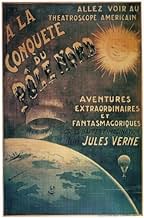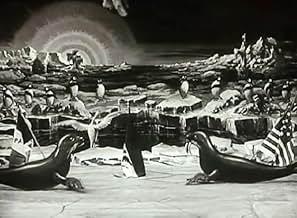ÉVALUATION IMDb
6,8/10
1,3 k
MA NOTE
Ajouter une intrigue dans votre langueAboard the futuristic flying machine of his own invention, Professor Mabouloff and his team of intercultural explorers set off on yet another impossible expedition to North Pole's vast lands... Tout lireAboard the futuristic flying machine of his own invention, Professor Mabouloff and his team of intercultural explorers set off on yet another impossible expedition to North Pole's vast landscapes. What wonders await the bold adventurers?Aboard the futuristic flying machine of his own invention, Professor Mabouloff and his team of intercultural explorers set off on yet another impossible expedition to North Pole's vast landscapes. What wonders await the bold adventurers?
Avis en vedette
The great French innovator finally seems to be running out of imagination here. Having invented cinema as we understand it today, he eventually had to exhaust his fount of inspiration.
This film could best be described as a remake of his "Voyage to the Moon" from 1902. Unfortunately much of the old vim is missing. Sequences run on for too long. At times the film seems more primitive than many of his earlier films.
Still, there was life in the old boy yet. The « géant des neiges » (giant of the snows) episode is quite good with a monster who swallows intrepid Arctic explorers whole. The ice giant is about as good an effect as Fafner the dragon in Fritz Lang's "Siegfried", and that film was made in 1924. There is a funny moment when the explorers reach the Earth's Magnetic Pole. They are attracted right onto the needle they find and get stuck there.
The long (too long) scene where the explorers in their airship fly past the signs of the zodiac reminded me strangely of what Dorothy sees from her window as she is caught in the tornado in "The Wizard of Oz". That would make Méliès nearly 30 years ahead of his time.
Nevertheless, I got the same impression I get with a lot of modern special effects films. Méliès was spending more money without necessarily expending more ingenuity. Perhaps he was only trying to imitate the lesser but more successful mortals who came after him.
This film could best be described as a remake of his "Voyage to the Moon" from 1902. Unfortunately much of the old vim is missing. Sequences run on for too long. At times the film seems more primitive than many of his earlier films.
Still, there was life in the old boy yet. The « géant des neiges » (giant of the snows) episode is quite good with a monster who swallows intrepid Arctic explorers whole. The ice giant is about as good an effect as Fafner the dragon in Fritz Lang's "Siegfried", and that film was made in 1924. There is a funny moment when the explorers reach the Earth's Magnetic Pole. They are attracted right onto the needle they find and get stuck there.
The long (too long) scene where the explorers in their airship fly past the signs of the zodiac reminded me strangely of what Dorothy sees from her window as she is caught in the tornado in "The Wizard of Oz". That would make Méliès nearly 30 years ahead of his time.
Nevertheless, I got the same impression I get with a lot of modern special effects films. Méliès was spending more money without necessarily expending more ingenuity. Perhaps he was only trying to imitate the lesser but more successful mortals who came after him.
Conquest of the North Pole (1912)
aka Conquete du pole, La
*** (out of 4)
Georges Melies film that tries to rival his legendary A Trip to the Moon but doesn't come that close. A group of scientists try to determine a way to reach the North Pole. Once there they must do battle with a large ice monster. The stuff dealing with the ice monster was terrific and this creature is one of the best of Melies career.
In early 2008 there will be a box set released and will feature over 170 Melies' shorts.
aka Conquete du pole, La
*** (out of 4)
Georges Melies film that tries to rival his legendary A Trip to the Moon but doesn't come that close. A group of scientists try to determine a way to reach the North Pole. Once there they must do battle with a large ice monster. The stuff dealing with the ice monster was terrific and this creature is one of the best of Melies career.
In early 2008 there will be a box set released and will feature over 170 Melies' shorts.
I really enjoyed this movie. Some of the other users have complained that there are scenes that don't advance the plot. I can't say this really bothers me in a movie that's less than ten minutes long.
I was most impressed by the production design. The sets and backdrops were lovely, and the whole film has a coherent look. The makers of this film obviously put a lot of effort into creating their fantasy world. Even if the journey through the zodiac didn't move the story forward, it held my attention because it was so imaginative and so beautiful.
While the effects are primitive by today's standards, they work because they're consistent with the design as a whole. Modern special effects are much more sophisticated, but that means nothing if they aren't smoothly integrated into the rest of the film. Melies and his collaborators created a world that I wanted to believe in.
I was most impressed by the production design. The sets and backdrops were lovely, and the whole film has a coherent look. The makers of this film obviously put a lot of effort into creating their fantasy world. Even if the journey through the zodiac didn't move the story forward, it held my attention because it was so imaginative and so beautiful.
While the effects are primitive by today's standards, they work because they're consistent with the design as a whole. Modern special effects are much more sophisticated, but that means nothing if they aren't smoothly integrated into the rest of the film. Melies and his collaborators created a world that I wanted to believe in.
Méliès made some pretty weird features, and this is one of the strangest. It's certainly entertaining to watch, and at times it reminds you of "Trip to the Moon", although it is not as good. The main difference is that "Conquest of the Pole" has more padding, material that doesn't go anywhere other than to set up some camera tricks. Yet it's still worth seeing, and it is filled with interesting visual effects.
The story itself, based on another Jules Verne story, starts off in a fashion similar to some other Méliès adaptations of Verne, this time with a scientist detailing his plans to go to the North Pole. It gets bizarre pretty fast, and many of the conceptions seem unnecessarily wacky. Yet there is always plenty to see on the screen, and Méliès's imagination is displayed in numerous ways. It's an interesting feature that is worth seeing for anyone who finds the great visual effects pioneer's movies interesting or enjoyable.
The story itself, based on another Jules Verne story, starts off in a fashion similar to some other Méliès adaptations of Verne, this time with a scientist detailing his plans to go to the North Pole. It gets bizarre pretty fast, and many of the conceptions seem unnecessarily wacky. Yet there is always plenty to see on the screen, and Méliès's imagination is displayed in numerous ways. It's an interesting feature that is worth seeing for anyone who finds the great visual effects pioneer's movies interesting or enjoyable.
Why one has to go into outer space to get to the North Pole is a question to ponder. Apparently, there were numerous expeditions going and the airship appears to be the one that succeeds. After forming diverse crew from several countries and throwing out the women, the air bus embarks on its journey. It goes past several constellations, including Scorpio and Pisces as well as Gemini. When the explorers finally get to the North Pole, there is really nothing to do. They run around and meet up with a monster and one of them gets eaten. Since they were from all countries, the monster got to choose between German, French, Chinese, Spanish, etc. This could have been played for laughs but wasn't. Anyway, it is all visual and the whole process of exploring is wasted. These guys really don't have a clue. As for Melies, he is still doing the same stuff.
Le saviez-vous
- AnecdotesThe film takes part of its inspiration from contemporary affairs surrounding the competing claims of Robert E. Peary and Frederick Cook over who had first reached the North Pole. Peary claimed he had reached the North Pole on 6 April 1909, however Cook, claimed he had done so a year earlier, on 21 April 1908. Méliès is quoted as saying that he thought both had pretended to have reached the North Pole, so he decided he was going to go there.
- ConnexionsEdited into Attack of the 50 Foot Monster Mania (1999)
Meilleurs choix
Connectez-vous pour évaluer et surveiller les recommandations personnalisées
Détails
- Durée33 minutes
- Couleur
- Mixage
- Rapport de forme
- 1.37 : 1
Contribuer à cette page
Suggérer une modification ou ajouter du contenu manquant

Lacune principale
By what name was À la conquête du pôle (1912) officially released in Canada in English?
Répondre




















